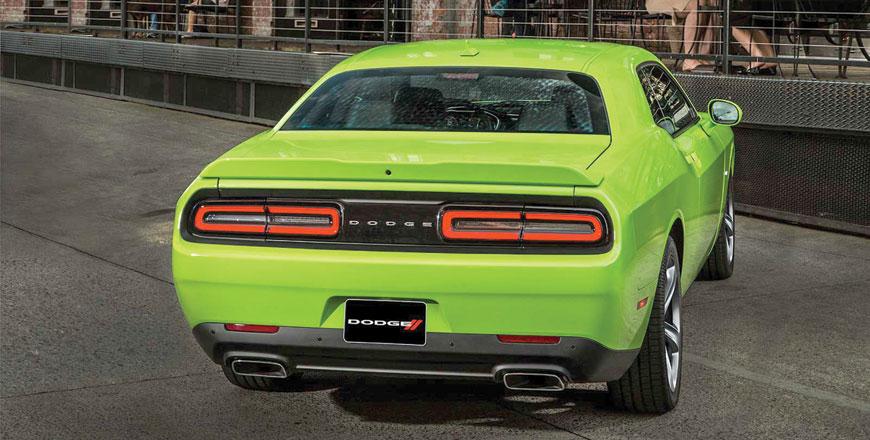You are here
Dodge Charger R/T: A rare commodity
By Ghaith Madadha - May 22,2017 - Last updated at May 22,2017

Photo courtesy of Dodge
As a more mainstream brand large comfortable, spacious and sporty large rear-drive saloon, the Dodge Charger is a rare but appreciated commodity at a time when such cars are usually the preserve of pricier premium brands.
In a state of near continuous development the current iteration of Dodge’s long-running Charger arrived in 2015 as a face-lifted model with heavily revised design, reworked interior, improved infotainment system and a standard 8-speed automatic gearbox across the range, including the mid-range 5.7-litre V8 powered R/T.
Moody and modern
Incrementally upgraded since first arriving in 2006 based on the LX platform, developed during Dodge’s parent Chrysler brand’s association with Mercedes-Benz, the second generation arrived as an evolutionary model using an upgraded LD platform by 2012.
Sporting a more contemporary front with rounded lights, deep-set yet slim and level grille, the 2015 Charger has a distinctly more modern aesthetic than its overtly retro-influenced predecessor, but is said to be subtly influenced by the moody, dramatic and now iconic 1969 Charger coupe.
Long, wide and comparatively low, with discretely scalloped bonnet ridges, recessed grille and LED outline for its browed headlight units, the Charger has a moody and assertive presence, while a black centre bumper section lends its fascia a longer and hungrier edge in R/T spec, as driven.
Sculpted and chiselled with deeply ridged sides and a rakishly descends roofline create a sense of motion and are little changed for 2015. Meanwhile its full-length rear lights are reminiscent of the 1960s and 1970s Chargers.
Relaxed yet muscular
Offered with four engine options including a V6 and two high performance SRT and SRT Hellcat V8 units, the driven R/T is the most traditional, and the only non-SRT division V8 version. Carried over unchanged, the R/T’s muscular yet languid naturally aspirated 5.7-litre HEMI V8 engine is a compact and traditional American overhead 16-valve design.
Robust and progressive in power delivery yet rich in torque across the range, it pulls responsively off the line, if without the jackhammer urgency and relentlessness of the SRT versions.
Charismatic and rumbling, the Charger R/T’s 5.7 Hemi is distinctly low-revving in character, with a 5800rpm rev limit and is capable of running on cheaper grade 91RON petrol (93RON is recommended). At its best in its abundant mid-range, it is flexible and muscular, if not heady and peaky. Developing 370BHP at 5250rpm and 395lb/ft, the Charger R/T is progressive and responsive, and in the absence of official figures, is estimated to carry its hefty 1934kg mass through the 0-100km/h dash swiftly in around 5.5-seconds.
Confident comfort
With responsive throttle control and progressive delivery the Charger R/T effectively puts power down through its driven rear wheels, with less need for stability control interventions than more powerful iterations. Its smooth and slick shifting 8-speed gearbox with its numerous ratios including more aggressive lower gears and more relaxed higher gears provides improved acceleration, flexibility, refinement and efficiency. One, however, feels that the Charger R/T would have been better served with the 390BHP and 410b/ft version of the same engine as deployed its Ram 1500 stable-mate.
A large and weighty, but well-balanced, saloon, the Charger drives with confidence and stability at speed and through corners, as demonstrated during test drive at Abu Dhabi’s Yas Marina Formula 1 circuit.
Fitted with fixed rate “performance suspension” in Dodge-speak, the Charger R/T’s body control is good for its size and weight, but is set-up for a more comfortable ride than its more tautly set-up high performance SRT sister models, and so leans more, but feels more supple and forgiving, and less firmly buttoned down.
Refined and accommodating
Composed, compliant and more agile than its size suggests, the R/T rides on huge 245/45R20, while its electric-assisted steering is accurate and quick at 2.6-turns lock-to-lock, but isn’t into as crisp or tidily composed turning into corners as the next model up, the SRT 392, which seems to be the best resolved model in the charger range.
Highly refined inside and well insulated, the Charger R/T instils confidence and through corners feels balanced, with slight understeer on turn-in if pushed too hard. Its long wheelbase and large tyres provide good rear grip and progressive weight shift.
A vast and accommodating saloon, the Charger R/T’s cabin is hunkered down owing to its high window line, but is spacious and features very comfortable seats. In front room and visibility are good, while boot space and rear cabin width and legroom are plus points.
Rear headroom is fine, but considering its rakish roofline, the Charger’s rear seats are positioned slightly higher than ideal. Well-finished with good quality layouts, textures and high equipment levels, the Charger features an intuitive, versatile and highly capable Uconnect infotainment system.
TECHNICAL SPECIFICATIONS
Engine: 5.7-litre, cast-iron block/aluminium head, in-line V8-cylinders
Bore x Stroke: 99.5 x 90.9mm
Compression ratio: 10.5:1
Valve-train: 16-valve, OHV
Gearbox: 8-speed automatic, rear-wheel-drive, electronic limited-slip differential
Gear ratios: 1st 4.70 2nd 3.13 3rd 2.10 4th 1.67 5th 1.28 6th 1.0 7th 0.84 8th 0.67
Reverse/final drive ratios: 3.53/2.62
Power, BHP (PS) [kW]: 370 (375) [277] @5250rpm
Specific power: 65.4BHP/litre
Power-to-weight: 191.3BHP/ton
Torque lb/ft (Nm): 395 (536) @4200rpm
Specific torque: 94.8Nm/litre
Torque-to-weight: 277.1Nm/tonne
Rev limit: 5800rpm
0-100km/h: 5.5-seconds (est.)
Top speed: 235km/h (est.)
Fuel consumption, city/highway: 14.7-/9.4-litres/100km
Fuel capacity: 70-litres
Fuel requirement, recommended (minimum): 93(91)RON
Length: 5040mm
Width: 1905mm
Height: 1479mm
Wheelbase: 3052mm
Track, F/R: 1610/1620mm
Ground clearance: 136mm
Kerb weight: 1934kg
Weight distribution, F/R: 53 per cent/47 per cent
Aerodynamic drag co-efficiency: 0.304
Headroom, F/R: 981/930mm
Legroom, F/R: 1061/1019mm
Shoulder room, F/R: 1510/1472mm
Hip room, F/R: 1428/1425mm
Cargo volume: 467-litres
Steering: Electric-assisted rack & pinion
Turning circle: 11.5-metres
Lock-to-lock: 2.6-turns
Suspension F/R: Unequal double wishbones/multi-link
Brakes, F/R: Ventilated perforated discs 345 x 28mm/320 x 22mm
Brake callipers, F/R: 2-/1-pistons
Tyres: 245/45R20
Related Articles
First introduced in its modern iteration in 2006 as a more sophisticated interpretation of the American saloon, with its combination of aggr
Introduced as a 2008 model heavily influenced by the ionic original 1970-74, the revived third generation Challenger was Dodge’s gambit into
Part of a heavily revised Dodge Charger line-up introduced for 2015, the SRT 392 receives a slight power hike and new gearbox to go with its


















